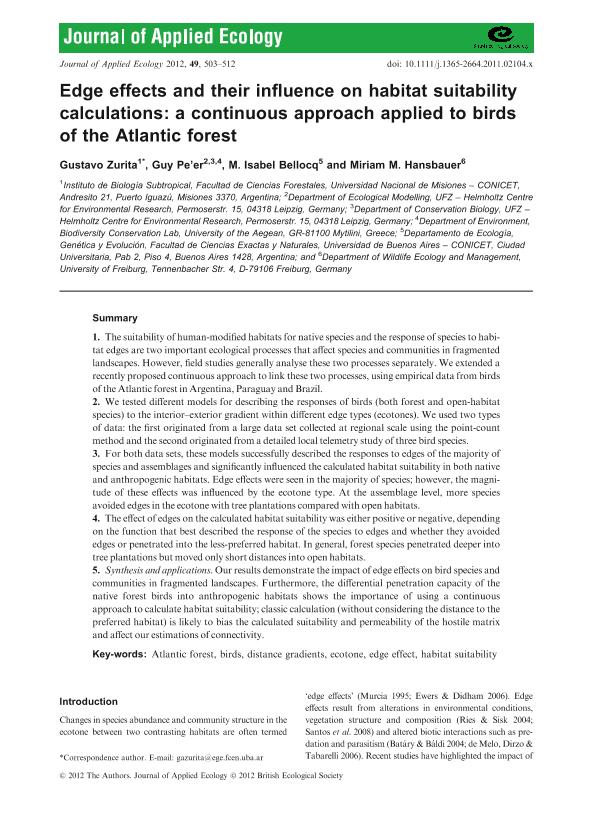Mostrar el registro sencillo del ítem
dc.contributor.author
Zurita, Gustavo Andres

dc.contributor.author
Pe'er, Guy
dc.contributor.author
Bellocq, Maria Isabel

dc.contributor.author
Hansbauer, Miriam M.
dc.date.available
2019-01-17T19:58:21Z
dc.date.issued
2012-04
dc.identifier.citation
Zurita, Gustavo Andres; Pe'er, Guy; Bellocq, Maria Isabel; Hansbauer, Miriam M.; Edge effects and their influence on habitat suitability calculations: A continuous approach applied to birds of the Atlantic forest; Wiley Blackwell Publishing, Inc; Journal of Applied Ecology; 49; 2; 4-2012; 503-512
dc.identifier.issn
0021-8901
dc.identifier.uri
http://hdl.handle.net/11336/68221
dc.description.abstract
1.The suitability of human-modified habitats for native species and the response of species to habitat edges are two important ecological processes that affect species and communities in fragmented landscapes. However, field studies generally analyse these two processes separately. We extended a recently proposed continuous approach to link these two processes, using empirical data from birds of the Atlantic forest in Argentina, Paraguay and Brazil. 2.We tested different models for describing the responses of birds (both forest and open-habitat species) to the interior-exterior gradient within different edge types (ecotones). We used two types of data: the first originated from a large data set collected at regional scale using the point-count method and the second originated from a detailed local telemetry study of three bird species. 3.For both data sets, these models successfully described the responses to edges of the majority of species and assemblages and significantly influenced the calculated habitat suitability in both native and anthropogenic habitats. Edge effects were seen in the majority of species; however, the magnitude of these effects was influenced by the ecotone type. At the assemblage level, more species avoided edges in the ecotone with tree plantations compared with open habitats. 4.The effect of edges on the calculated habitat suitability was either positive or negative, depending on the function that best described the response of the species to edges and whether they avoided edges or penetrated into the less-preferred habitat. In general, forest species penetrated deeper into tree plantations but moved only short distances into open habitats. 5.Synthesis and applications. Our results demonstrate the impact of edge effects on bird species and communities in fragmented landscapes. Furthermore, the differential penetration capacity of the native forest birds into anthropogenic habitats shows the importance of using a continuous approach to calculate habitat suitability; classic calculation (without considering the distance to the preferred habitat) is likely to bias the calculated suitability and permeability of the hostile matrix and affect our estimations of connectivity.
dc.format
application/pdf
dc.language.iso
eng
dc.publisher
Wiley Blackwell Publishing, Inc

dc.rights
info:eu-repo/semantics/openAccess
dc.rights.uri
https://creativecommons.org/licenses/by-nc-sa/2.5/ar/
dc.subject
Atlantic Forest
dc.subject
Birds
dc.subject
Distance Gradients
dc.subject
Ecotone
dc.subject
Edge Effect
dc.subject
Habitat Suitability
dc.subject.classification
Otras Ciencias Biológicas

dc.subject.classification
Ciencias Biológicas

dc.subject.classification
CIENCIAS NATURALES Y EXACTAS

dc.title
Edge effects and their influence on habitat suitability calculations: A continuous approach applied to birds of the Atlantic forest
dc.type
info:eu-repo/semantics/article
dc.type
info:ar-repo/semantics/artículo
dc.type
info:eu-repo/semantics/publishedVersion
dc.date.updated
2019-01-17T13:56:08Z
dc.journal.volume
49
dc.journal.number
2
dc.journal.pagination
503-512
dc.journal.pais
Reino Unido

dc.journal.ciudad
Londres
dc.description.fil
Fil: Zurita, Gustavo Andres. Consejo Nacional de Investigaciones Científicas y Técnicas. Centro Científico Tecnológico Conicet - Nordeste. Instituto de Biología Subtropical. Instituto de Biología Subtropical - Nodo Puerto Iguazú | Universidad Nacional de Misiones. Instituto de Biología Subtropical. Instituto de Biología Subtropical - Nodo Puerto Iguazú; Argentina
dc.description.fil
Fil: Pe'er, Guy. Helmholtz Centre for Environmental Research; Alemania. University of the Aegean; Grecia
dc.description.fil
Fil: Bellocq, Maria Isabel. Universidad de Buenos Aires. Facultad de Ciencias Exactas y Naturales. Departamento de Ecología, Genética y Evolución; Argentina. Consejo Nacional de Investigaciones Científicas y Técnicas; Argentina
dc.description.fil
Fil: Hansbauer, Miriam M.. University of Freiburg; Alemania
dc.journal.title
Journal of Applied Ecology

dc.relation.alternativeid
info:eu-repo/semantics/altIdentifier/doi/http://dx.doi.org/10.1111/j.1365-2664.2011.02104.x
dc.relation.alternativeid
info:eu-repo/semantics/altIdentifier/url/https://besjournals.onlinelibrary.wiley.com/doi/full/10.1111/j.1365-2664.2011.02104.x
Archivos asociados
